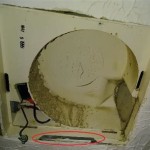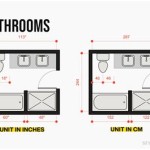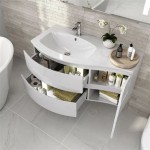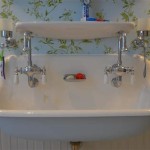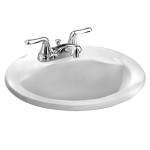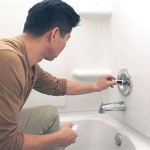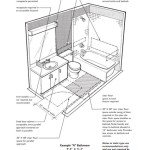```html
Bathroom Sink Drain Airlock: Understanding and Resolving the Issue
A bathroom sink drain airlock is a common plumbing problem that can cause significant inconvenience. It occurs when a bubble of air becomes trapped within the drainpipe, preventing water from flowing freely. This trapped air essentially creates a blockage, hindering the drainage process and potentially leading to standing water in the sink. Understanding the causes, symptoms, and solutions for this issue is crucial for homeowners to maintain a functional and hygienic bathroom environment.
The presence of an airlock can manifest in various ways, from slow drainage to a complete blockage. Identifying the specific symptoms is the first step in diagnosing the problem. Once diagnosed, there are several methods that can be employed to address the airlock, ranging from simple DIY techniques to more involved plumbing procedures. Early intervention is key to preventing the problem from escalating and potentially causing damage to the plumbing system.
Causes of Bathroom Sink Drain Airlocks
Several factors can contribute to the formation of an airlock in a bathroom sink drain. These factors often relate to the design of the plumbing system, the accumulation of debris, or alterations made to the existing plumbing infrastructure. Understanding these underlying causes can help in preventing future occurrences of airlocks.
Improper Venting: One of the most common causes of an airlock is inadequate venting. Plumbing systems rely on vents to allow air to enter the drainpipes, facilitating the smooth flow of water. These vents typically extend to the roof of the house, providing a route for air to escape. If a vent becomes blocked by debris such as leaves, bird nests, or ice, it can disrupt the airflow, leading to negative pressure within the drainpipe. This negative pressure can then draw air into the drain, creating an airlock.
S-Traps: Older plumbing systems often utilize S-traps beneath sinks. While these traps were designed to prevent sewer gases from entering the home, they are more prone to siphonage than modern P-traps. Siphonage occurs when the water in the trap is completely sucked out, leaving the drainpipe open to air intake. This can create an airlock, especially if the drainpipe is long or has multiple bends.
Partial Blockages: The accumulation of hair, soap scum, and other debris within the drainpipe can create partial blockages. These blockages restrict the flow of water, creating turbulence and increasing the likelihood of air becoming trapped. Over time, these partial blockages can worsen, further exacerbating the airlock problem.
Plumbing Modifications: Alterations to the plumbing system, such as adding new fixtures or rerouting drainpipes, can sometimes inadvertently create conditions that favor airlock formation. If the new plumbing is not properly vented or if the drainpipe is excessively long or has too many bends, it can increase the risk of air becoming trapped.
Symptoms of a Bathroom Sink Drain Airlock
Recognizing the symptoms of a bathroom sink drain airlock is essential for prompt diagnosis and resolution. The symptoms can range from subtle to severe, depending on the extent of the blockage and the severity of the airlock.
Slow Drainage: One of the earliest and most common symptoms is slow drainage. Water may take significantly longer to drain from the sink than usual. This is because the trapped air is restricting the flow of water through the drainpipe. In some cases, the slow drainage may be intermittent, occurring only at certain times or after using a large volume of water.
Gurgling Sounds: Gurgling sounds emanating from the drainpipe are another telltale sign of an airlock. These sounds are caused by air bubbles moving around in the drainpipe as water attempts to flow past them. The gurgling sound may be accompanied by a bubbling or hissing noise.
Water Backup: In severe cases, an airlock can cause water to back up in the sink. This occurs when the trapped air completely blocks the drainpipe, preventing any water from flowing through. The water level in the sink may rise significantly, potentially overflowing onto the countertop if left unattended.
Unpleasant Odors: A stagnant pool of water trapped in the drainpipe due to an airlock can create an environment conducive to bacterial growth. This bacterial growth can produce unpleasant odors that emanate from the sink drain. The odors may be particularly noticeable after using the sink or when the bathroom is humid.
Toilet Bowl Issues: In some instances, a severe airlock in the bathroom sink drain can affect the performance of nearby toilets. The airlock can create negative pressure in the plumbing system, which can then interfere with the flushing action of the toilet. This may manifest as slow flushing, weak flushing, or even a complete failure to flush.
Methods for Resolving a Bathroom Sink Drain Airlock
Several methods can be employed to resolve a bathroom sink drain airlock, ranging from simple DIY techniques to more involved plumbing procedures. The choice of method will depend on the severity of the airlock and the homeowner's skill level.
Plunger: A plunger is a common household tool that can be effective in dislodging airlocks. To use a plunger effectively, fill the sink with enough water to cover the cup of the plunger. Ensure that the plunger is creating a tight seal around the drain opening. Then, plunge vigorously up and down for several minutes. The pressure created by the plunging action can help to dislodge the airlock and allow water to flow freely.
Baking Soda and Vinegar: A mixture of baking soda and vinegar can be used to create a chemical reaction that helps to break down debris and dislodge airlocks. Pour one cup of baking soda down the drain, followed by one cup of vinegar. Allow the mixture to fizz for about 30 minutes. Then, flush the drain with hot water. The bubbling action of the baking soda and vinegar can help to loosen debris and clear the airlock.
Bent Wire or Drain Snake: A bent wire or drain snake can be used to manually dislodge an airlock or clear any obstructions in the drainpipe. Carefully insert the wire or snake into the drain opening and push it down the drainpipe. Rotate the wire or snake as you push it down to help break up any debris. Once you feel the obstruction loosen, flush the drain with hot water.
Check the Vent: Inspect the plumbing vent on the roof of the house for any blockages. Use a garden hose or a plumbing snake to clear any debris that may be obstructing the vent. Clear vents are essential for proper airflow within the plumbing system, preventing the formation of airlocks.
P-Trap Removal and Cleaning: The P-trap, the curved section of pipe beneath the sink, is a common location for debris to accumulate and airlocks to form. Place a bucket beneath the P-trap to catch any water. Carefully loosen the slip nuts that connect the P-trap to the drainpipe. Remove the P-trap and clean out any debris that may be trapped inside. Reassemble the P-trap and tighten the slip nuts securely.
Professional Plumber: If the above methods fail to resolve the airlock, or if the homeowner is uncomfortable performing plumbing repairs, it is best to consult with a professional plumber. A plumber has the expertise and tools to diagnose and resolve more complex airlock problems. They can also identify any underlying plumbing issues that may be contributing to the problem.
Preventing future occurrences of airlocks involves maintaining a clean drain and ensuring proper ventilation. Regularly flushing the drain with hot water, using drain strainers to catch hair and debris, and periodically inspecting the plumbing vent can help to prevent airlocks from forming. Addressing any plumbing issues promptly can also help to prevent the development of airlocks.
```
Experiencing Airlock In Your Plumbing System Robinson

Airlock In Pipes Here Is What To Do Mr Rooter Plumbing Of Central New Jersey

Signs Of An Air Lock In Your Plumbing System Rooter Hero

How To Deal With An Airlock

Experiencing Airlock In Your Plumbing System Robinson

How To Fix Airlock In Kitchen Sink Drain Simple Steps For Quick Solutions

Draining Plumbing With Compressed Air

How To Remove Air Locks Reigate Plumbing And Heating Services Kensign Engineering Ltd

15 Tips And Tricks For Faucets Sinks Family Handyman

How Do P Traps Work Spec Sense
Related Posts
